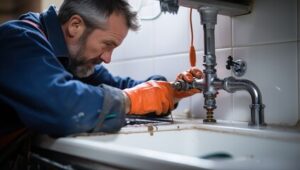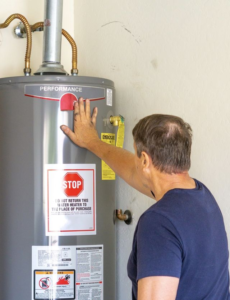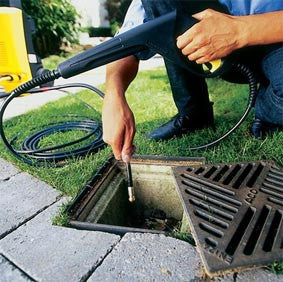Atlanta Plumbers install and repair water, waste, drainage, and sewage systems. Their skills ensure these essential systems meet safety regulations and function effectively in homes and businesses.
This trade requires technical knowledge, practical skills, and physical stamina. Plumbers must also be good at communicating with customers and interpreting complex plumbing problems in layperson’s terms.

Plumbers can install a variety of plumbing fixtures and appliances. These include sinks, toilets, bathtubs, showers, and water heaters. They can also install and repair gas lines. Some plumbers specialize in installing irrigation systems and other large-scale plumbing projects. These usually require the use of specialized tools and equipment. Others may install and repair septic systems. These are generally located in rural areas and are not connected to public sewer systems.
Another service offered by plumbers is to inspect and repair drainage systems. This involves checking for leaks and clogs and repairing or replacing damaged pipes and components. This service can be offered to residential and commercial customers. Plumbers who offer this service often have a truck-mounted unit that contains all the necessary tools and parts to complete the job quickly and efficiently.
A plumber can also provide emergency services. This includes responding to customer calls with a burst pipe or a clogged drain. In these situations, plumbers must assess the situation and provide solutions to resolve the issue as quickly as possible. This can be challenging as it requires them to work outside their normal business hours.
Other plumbing services that a plumber can offer include the installation of kitchen and bathroom cabinets. This is a great way to add value to a home and increase its resale value. In addition, plumbers can install garbage disposal units and replace or repair faucets and showerheads.
There are several ways that a plumber can get trained and licensed to work in this field. One is the traditional apprenticeship, which lasts four to five years and includes classroom instruction and paid on-the-job training. Another option is to attend a vocational school program that offers a certificate upon completion.
Some plumbers work as part of a larger team, while others are self-employed and work alone. Both plumbers can work in residential, commercial, or industrial settings. Commercial and industrial plumbers typically work on larger plumbing systems that serve multiple occupants, such as office buildings, hospitals, or factories. They can also work on fire sprinkler systems and other complex industrial plumbing equipment.
The plumbing industry is a very dynamic one. It involves a lot of repairs and installation work for residential and commercial spaces. Plumbers need good problem-solving skills as they often encounter issues beyond their knowledge. These problems include clogged drains, water leakages, broken toilets, and more. It is best to fix these problems immediately to prevent further damage and high repair costs.
Some common repair services that plumbers offer include fixing faulty water heaters, repairing leaking faucets, and installing new sinks or toilets. They can also help with water filtration systems to improve home water quality. This is a good idea for people with well water since it reduces the amount of contaminants in their drinking water.
Another service that plumbers provide is unclogging drains and sewer pipes. This can be done by using a camera to find the cause of the clog and then using a snake or hydrojetting to remove it. Clogged drains are a huge nuisance for homeowners, leading to serious health issues. Plumbers can fix these issues quickly and effectively.
In addition to repairing and installing various plumbing fixtures, these professionals can also handle gas line installations. This is a dangerous job, so plumbers must be licensed and have the proper training to do this work. When installing gas lines, plumbers must understand and follow complex building codes and regulations. This will ensure that the pipes are safe and secure.
Plumbers can also repair sewer lines. This is a crucial job, as it can prevent the spread of diseases caused by contaminated water. Plumbers must be able to identify and repair any problems in the sewage system before they cause major issues. This is a vital service for homeowners, as a damaged sewer line can lead to flooding and costly repairs.
Most plumbing companies have a service and repair division that handles emergencies. This team works around the clock to respond to calls from customers and address their concerns. This includes working after hours, on weekends, and during holidays. Plumbing companies need this team to ensure that their customers can receive the help they need when they need it.
In addition to installing pipes, plumbers can perform maintenance and repair services. These services may include unclogging drains, fixing water heaters, and repairing leaking faucets. They can also replace sewer lines and install new toilets. Plumbers are often required to work with a variety of tools and equipment. They also need to be able to read blueprints to understand the layout of the plumbing system in a building.
Plumbers must be able to identify problems quickly and come up with effective solutions. They must also be able to follow strict safety protocols when working on dangerous plumbing tasks. They are frequently exposed to hazardous materials, such as mold, and must wear protective gear. Also, plumbers must be able to tolerate heavy lifting and long periods on their feet.
Plumbing problems can be stressful, especially when handled poorly. In addition to the job’s physical demands, plumbers must be able to interact with customers professionally. They must be able to explain technical issues in an easy-to-understand way and offer reasonable estimates for their work. In addition, plumbers must be able to complete all their work promptly and within budget.
The benefits of a career as a plumber include job security and high satisfaction. This profession offers good wages and benefits, including medical insurance. Plumbers can work for large companies or start their own plumbing company. They can also become experts in a specific plumbing field, such as gas systems or rainwater collection.
No one likes dripping faucets or overflowing toilets, and these problems are often caused by leaky piping or faulty water fixtures. Plumbers are trained to inspect and repair these problems, which can save people a lot of money in the long run. In addition, plumbers help maintain the sewage and water systems in homes and businesses, protecting the population from dangerous diseases transmitted through contaminated water supplies. This is a great career choice for anyone who enjoys being around water and solving complicated problems.
Plumbing systems consist of pipes, fixtures, and appliances that provide water, gas, and waste disposal services for residential, commercial, and industrial properties. Plumbers install these systems in new buildings and repair or replace them when damaged. They also inspect and maintain existing plumbing to ensure the safety of occupants. Plumbers must have extensive knowledge of building codes and regulations to perform their duties. They use specialized tools and techniques to diagnose and repair issues.
When performing inspections, plumbers examine the condition of pipes and fixtures to determine if they need repairs or replacement. They check for leaks, clogs, and corrosion. They also test water pressure to ensure it is within the proper range. If they find any issues, they make recommendations and perform necessary repairs.
Plumbers are also responsible for inspecting and maintaining gas lines. They ensure these lines are properly installed and connected to stoves and furnaces. They may also be required to inspect and repair sewer systems, often composed of concrete and clay liners containing human waste and other debris. In these instances, plumbers must wear protective clothing and masks to avoid exposure to harmful bacteria and microbes.
During a plumbing inspection, the plumber evaluates all the visible pipes in a home’s structure. They look for signs of damage, rust, or corrosion. They also check for leaks and clogs and the integrity of the drain line. They may also note potential safety hazards, such as improper venting of exhaust gases or cross-contamination between water sources.
In addition to visual assessments, plumbers utilize specialized equipment like augers and snakes to clear clogs and other obstructions in drains and sewer lines. They also use cameras to inspect hard-to-reach areas of a property’s plumbing. These inspections help them identify problems that could be costly to fix down the road. For example, a clogged drain can lead to water overflow and mold growth, while faulty sewer lines can cause sewage back-ups and other hazardous conditions. Plumbing inspections also help homeowners prepare to sell their homes by providing documentation of the plumbing system’s condition.


